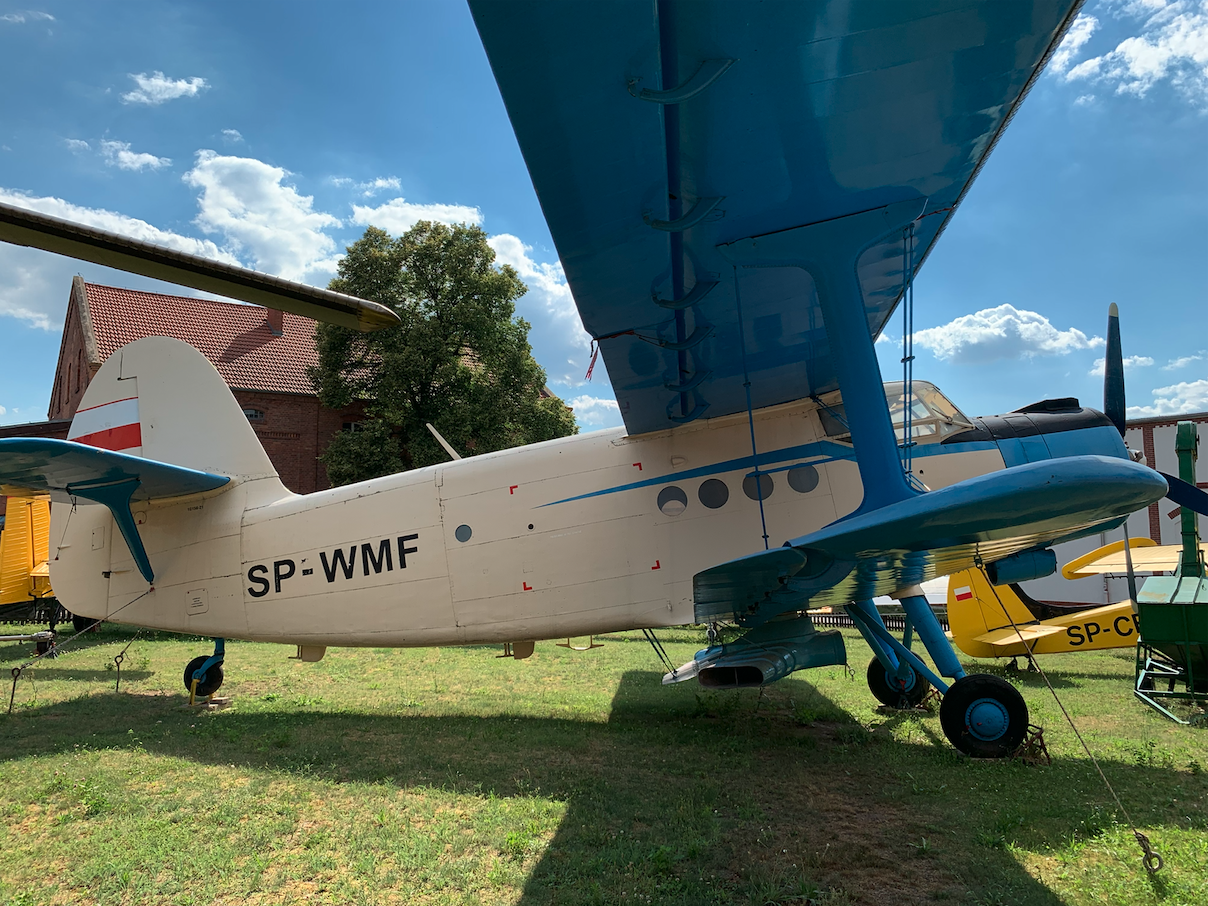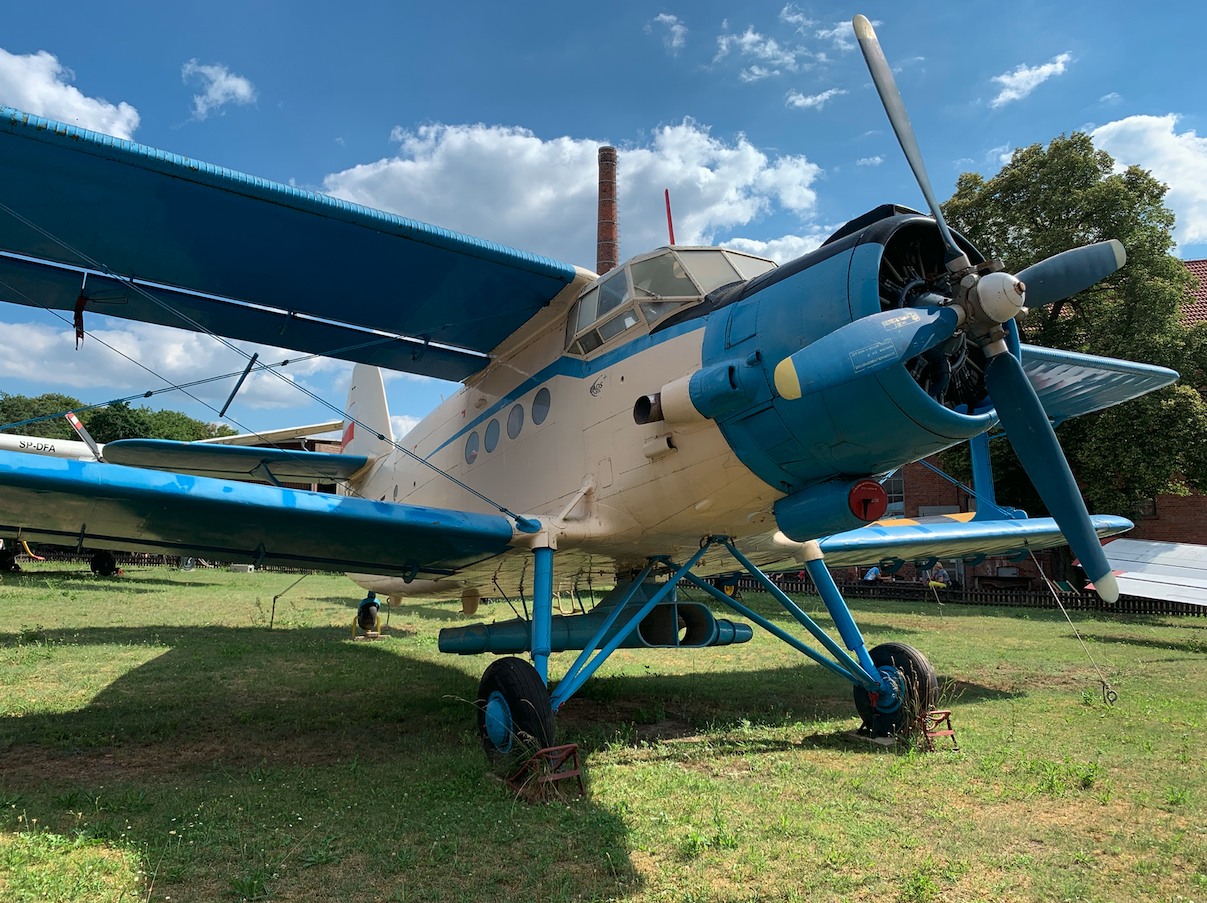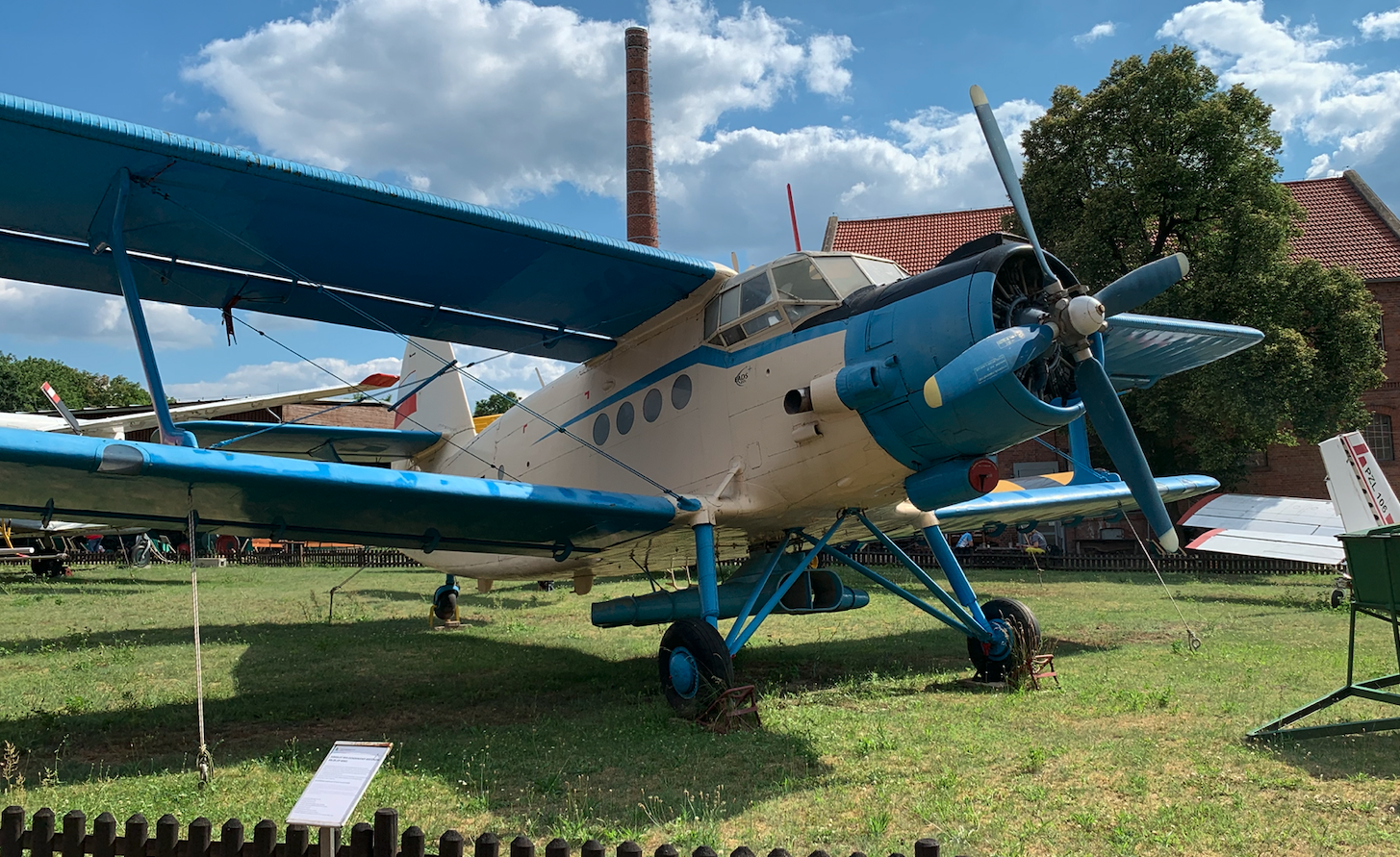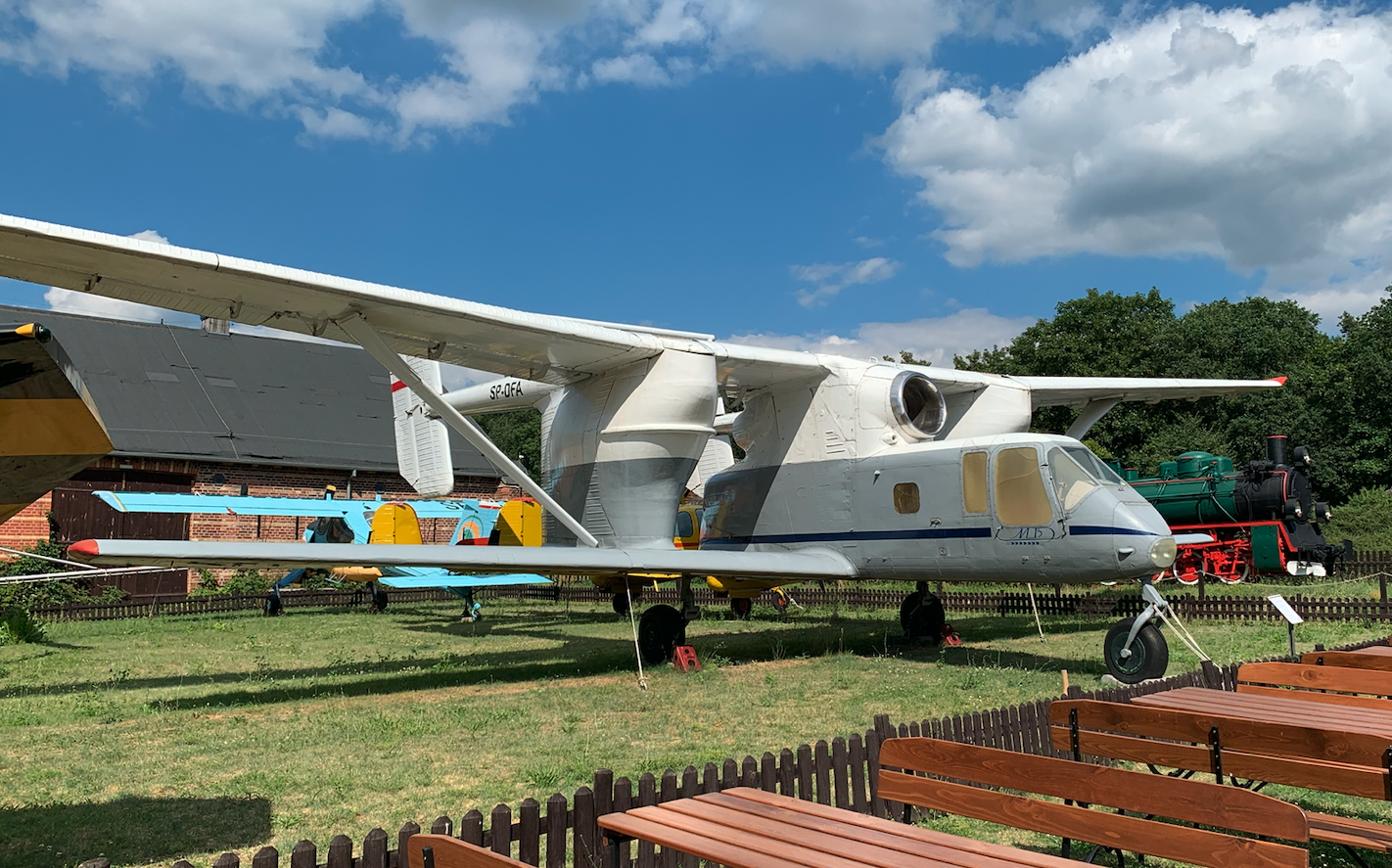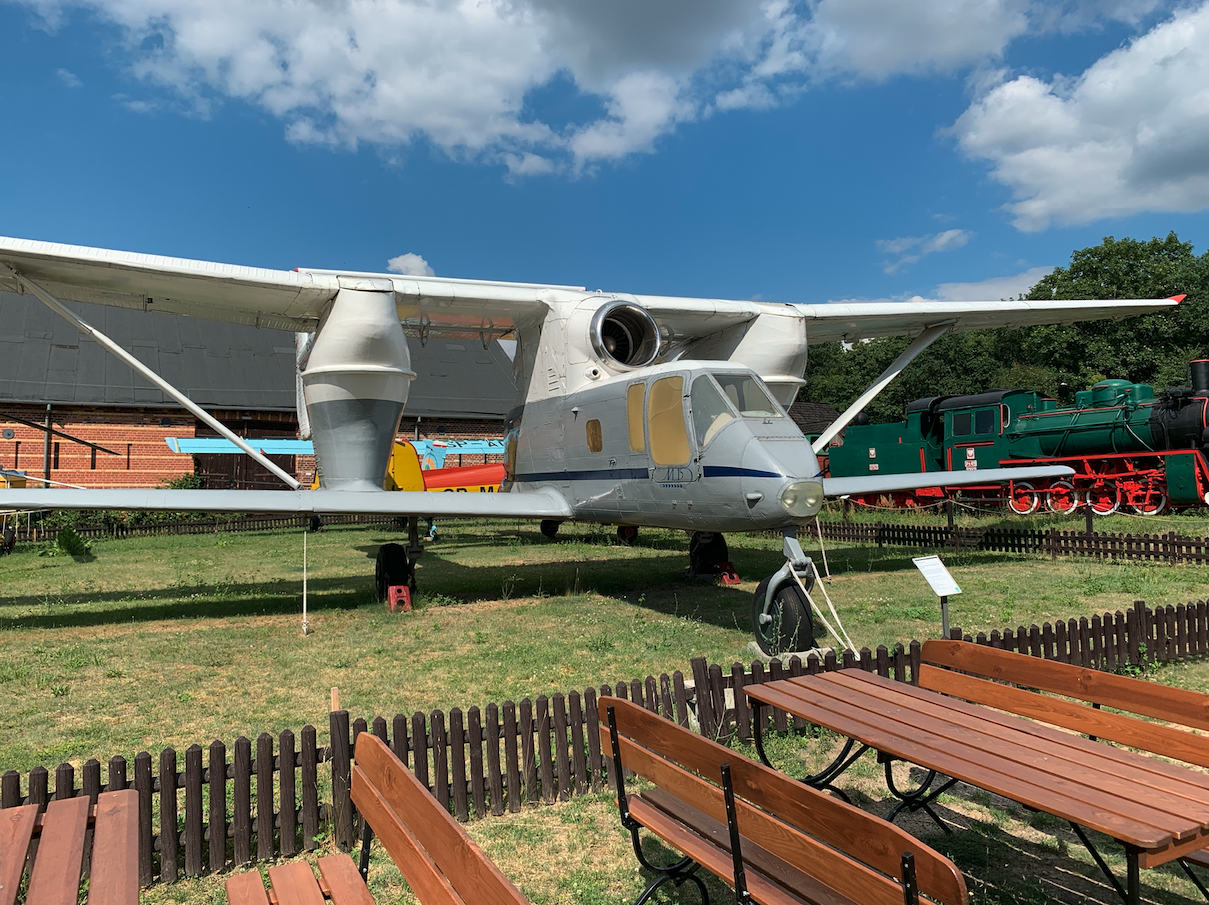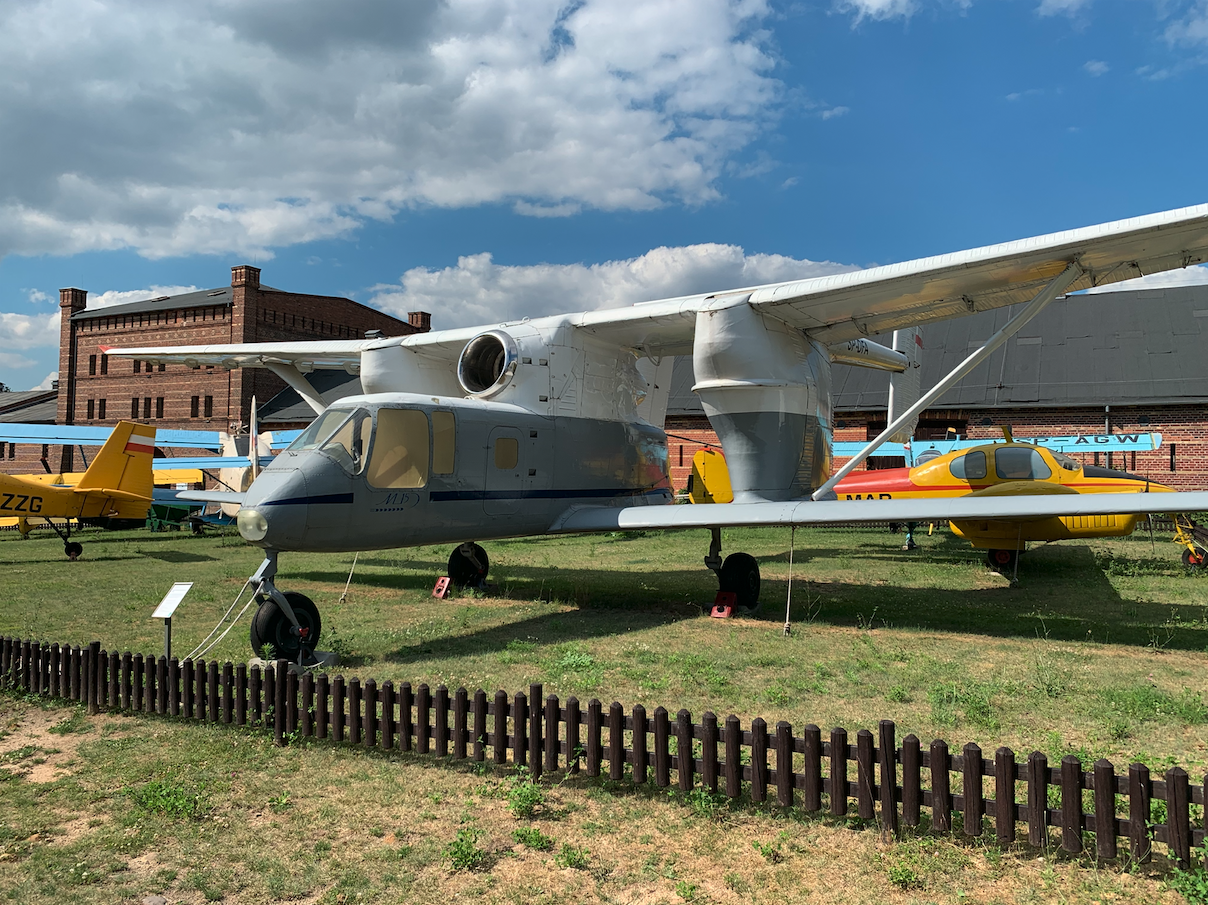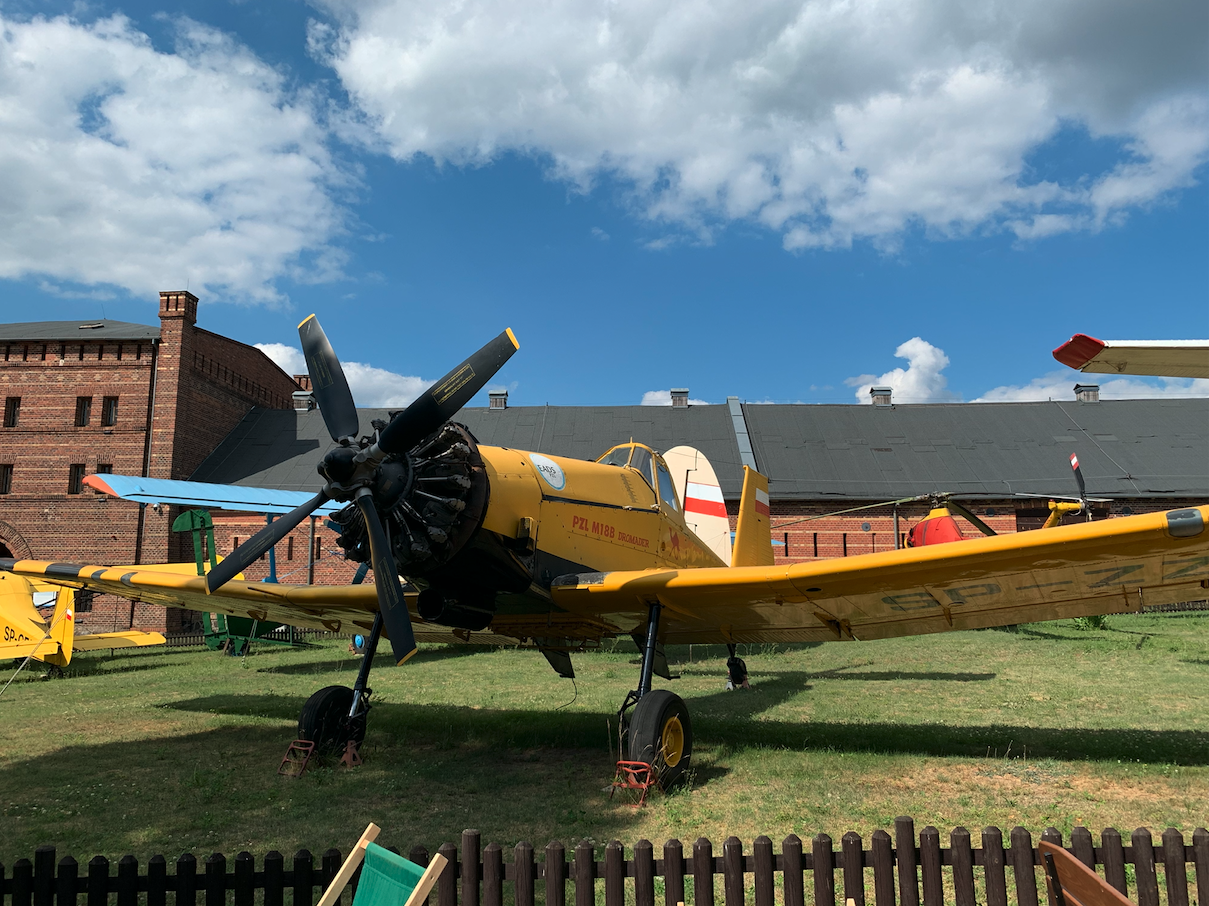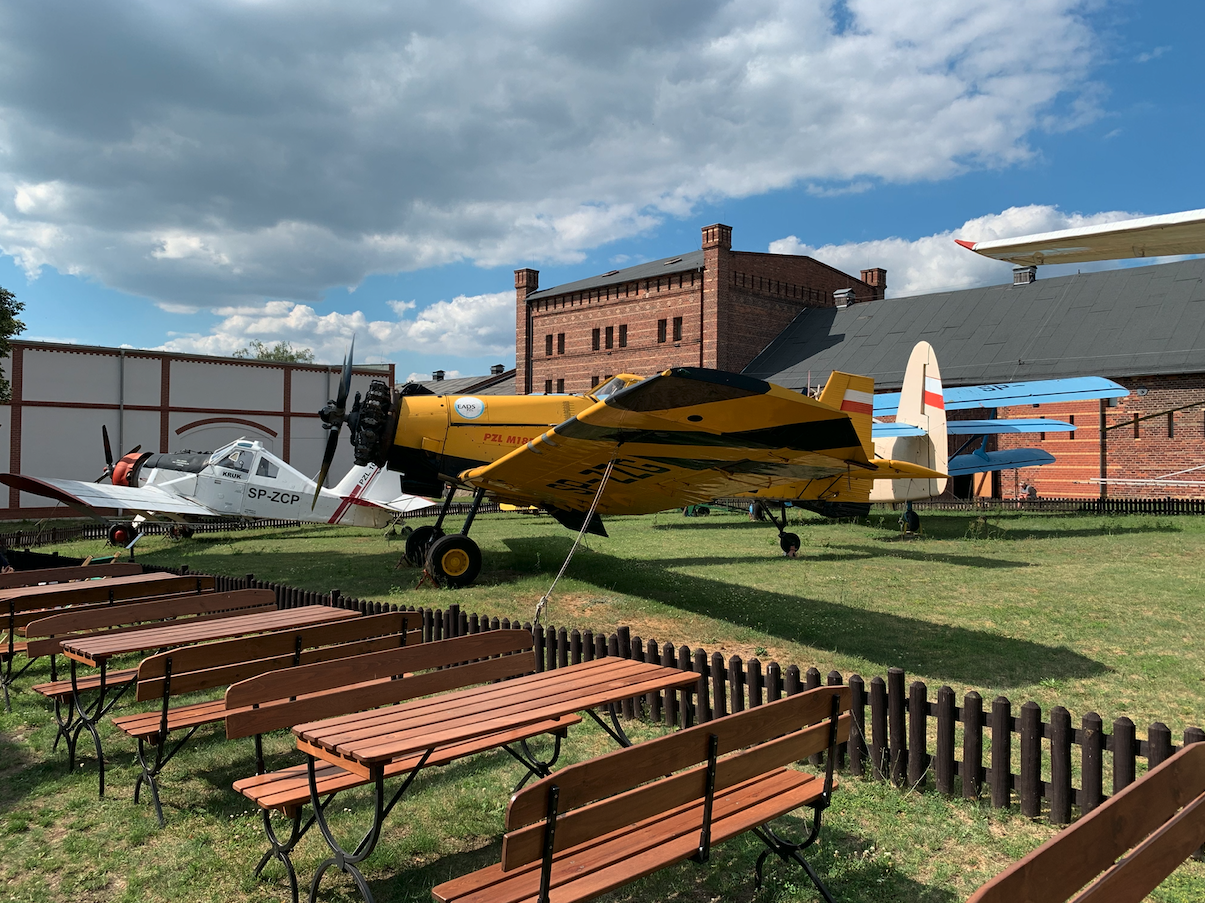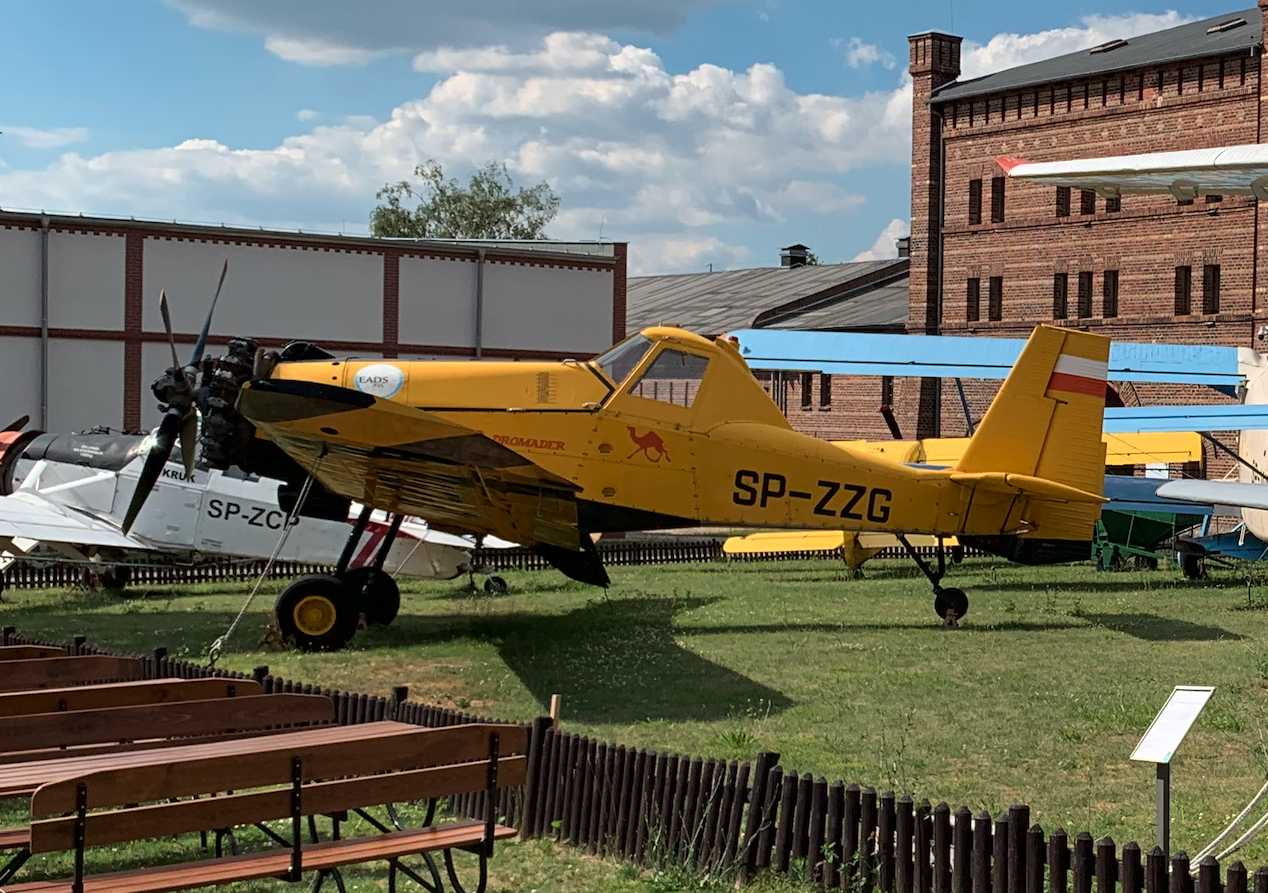Poznań 2021-08-31
Samoloty w Muzeum Rolnictwa w Szreniawie.
Muzeum Narodowe Rolnictwa i Przemysłu Rolno-Spożywczego w Szreniawie.
Współrzędne geograficzne: 52.315N 16.797E.
Ekspozycja Agrolotnictwo.
Muzeum w Szreniawie obok Poznania posiada największą kolekcję statków powietrznych, które były wykorzystywane w Polsce w rolnictwie i leśnictwie, na przestrzeni wieków. Jednocześnie dział ten jest szczegółowo omówiony i zaprezentowany.
Ekspozycja Agrolotnictwo posiada największe eksponaty w muzeum, ale nie najcięższe. W muzeum prezentowanych jest 9 oryginalnych statków powietrznych. Większość z nich była produkowana i eksploatowana w Polsce, Europie, Afryce, Ameryce Południowej i Północnej. Na ekspozycji otwartej znajdują się samoloty i jeden śmigłowiec. Wszystkie eksponaty są w oryginalnych barwach, w jakich te samoloty były użytkowane w Polsce.
PZL An-2 R, SP-WMF.
Samolot Antonow An-2 to była konstrukcja opracowana w zespole Antonowa w CCCP. Jednak moskale nie mieli możliwości produkcyjnych, bo wszystkie fabryki budowały samoloty bojowe. CCCP szukając nowej fabryki dla produkcji samolotów An-2 prowadziły rozmowy zarówno z Polską jak i z NRD ( niemiecka republika demokratyczna ) oraz Czechosłowacją. Wybór fabryki w Polsce był wyborem bardziej politycznym niż merytorycznym. Przypomnijmy, że w tym okresie w Polsce były prowadzone próby nowego samolotu transportowo-pasażerskiego MD-12, wyprzedzający o dwie generacje konstrukcję An-2. Na Kremlu słusznie wnioskowano, że monopol rosyjski może zostać zakłócony. Lokując produkcje An-2 w Polsce i gwarantując odbiór tych samolotów, miano niemal stuprocentową pewność, że program MD-12 upadnie. I tak się stało.
CCCP sprzedał Polsce prawa do produkcji An-2, jednocześnie zawierając umowę handlową na wieloletnie dostawy tych samolotów. W 1959 roku, do WSK Mielec dostarczono dokumentację licencyjną oraz samolot wzorcowy Nr 111519 wyprodukowany w 1959 roku. Samolot został zarejestrowany w Polsce pod znakami SP-ANA i produkcja ruszyła. Pierwsze 10 maszyn montowano z części dostarczonych z CCCP.
Pierwszy Polski An-2 wykonał pierwszy lot w dniu 23.10.1960 roku, a pilotem był pilot doświadczalny pan Tadeusz Gołębiewski. Pracownicy WSK Mielec szybko opanowali nową technologię i już od stycznia 1961 roku, ruszyła masowa produkcja z podzespołów wykonywanych wyłącznie w Polsce. Jednym z większych poddostawców były zakłady WSK Okęcie. Tam produkowano usterzenie pionowe i poziome, pływaki dla wersji wodnej, zbiorniki na chemikalia dla wersji rolniczej. W dniu 23.03.1961 roku, pierwszą partię przekazano odbiorcy ze Wschodu.
W 1961 roku, w zakładach WSK Kalisz ruszyła na prawach licencji produkcja silników ASz-62 IR o mocy 1 x 736 kW ( 1 x 1 000 KM ).
Duży wkład w unowocześnianie tej przestarzałej konstrukcji samolotu miał Instytut Lotnictwa. W 1962 roku, rozpoczęto w nim wszechstronne badania produkowanych w Polsce samolotów An-2. Dzięki temu udało się wiele elementów poprawić, unowocześnić, jednocześnie czyniąc maszynę bezpieczniejszą. W 1965 roku, w Instytucie Lotnictwa przeprowadzono testy aparatury do rozsiewania i oprysków chemicznych. Samolot An-2 R w wersji rolniczej był juz produkowany od 1961 roku, ale aparatura Agro nie była przebadana. An-2 R wyposażony był w dwojakiego rodzaju instalacje. Pierwsza służy do opylania sypkimi środkami chemicznymi. Druga do rozpryskiwania płynnych środków chemicznych. Zbiornik umieszczono w ładowni samolotu. Samoloty te wykorzystywano w rolnictwie i gospodarce leśnej.
PZL M-15 Belfegor SP-DFA Nr 1S00603. (Belphegor).
Program samolotu rolniczego PZL M-14 opracowany w Mielcu dla CCCP upadł. Niespodziewanie, CCCP zaproponował Polsce budowę zupełnie innego samolotu rolniczego, który opracował zespół inżyniera Riamira Adamowicza Izmaiłowa z Arseniewa. Wiosną 1971 roku, odbyło się kilka tur rozmów prowadzonych w Moskwie. Ponieważ to CCCP miał być głównym odbiorcą budowanych w PZL Mielec samolotów, dlatego strona Polska miała niewiele do powiedzenia. Zaskoczenie wywołał nie tyle układ samolotu, co jego zespół napędowy, złożony z jednego silnika turboodrzutowego, AI-25 stosowanego do napędu samolotów Jak-40. To na Kremlu zapadła decyzja, że samolot ma mieć udźwig 2 500 kg oraz że samolot ma mieć napęd turboodrzutowy.
Samolot rolniczy M-15 stał się pierwszym na świecie i jedynym z napędem turboodrzutowym. Strona wschodnia tłumaczyła wybór takiego silnika brakiem równie mocnego napędu tłokowego oraz chęcią ujednolicenia stosowanego w AEROFŁOT paliwa (!?). Argumenty mizerne, parząc na zużycie paliwa i hałas emitowany przez tego typu silniki. A przede wszystkim, cały cywilizowany świat wiedział, że silniki turboodrzutowe są nieekonomiczne przy małych zakresach prędkości postępowej. Cały świat, ale nie moskale.
Ustalono, że samolot zostanie opracowany przez wspólny zespół Polsko – CCCP. Z dwojga złego, strona Polska przystała na te warunki i samolot zmaterializował się w formie PZL M-15 Belfegor. Tym bardziej, że w pierwszych rozmowach strona CCCP zgłaszała zapotrzebowanie na 2 500 – 3 000 maszyn. Tak, tak. To nie pomyłka. Niebywałe również miało być tempo programu; zaledwie trzy lata. W 1974 roku, strona Polska miała już dostarczać samoloty do CCCP. Samolot otrzymał oznaczenie PZL M-15, a po Air Show w Paryżu w 1977 roku, do symbolu dodano nazwę Belfegor (Belphegor).
Samolot otrzymał nieprzeciętny kształt. Dwupłatowiec, z dwoma belkami wychodzącymi z górnego skrzydła, do których mocuje się duże usterzenie. Zbiorniki na chemikalia umieszczono między skrzydłami, w wielkich opływowych bańkach. Zastosowanie układu dwupłatowego, miało swoje uzasadnienie w dużej masie samolotu. Jednocześnie ograniczało rozpiętość maszyny. Kabina załogi została umieszczona w przedzie kadłuba, co zapewnia doskonałą widoczność, ale naraża na odniesienie dużych obrażeń w przypadku zderzenia z przeszkodą.
Prace projektowe rozpoczęto w lipcu 1971 roku. Projekt wstępny został ukończony w marcu 1972 roku. W czerwcu 1972 roku, zebrała się komisja makietowa i oceniła makietę samolotu w skali naturalnej. Projekt zatwierdzono i podjęto prace nad projektem technicznym. Układ samolotu został opatentowany w Polsce.
Prace nad M-15 postępowały szybko. Z końcem 1973 roku, pierwszy prototyp przekazano do prób lotniskowych. W dniu 9.01.1974 roku, prototyp Nr 1S 001-01 został oblatany. Za sterami siedział pilot doświadczalny inżynier Tadeusz Gołębiewski. W sumie powstały cztery prototypy; Nr 1S 001-01, Nr 1S 001-02, Nr 1S 001-03, Nr 1S 001-04. Różniły się one od siebie. Samolot Nr 1S 001-04 otrzymał zdwojone sterownice i został oblatany w 30.12.1975 roku, przez inżyniera Andrzeja Pamułę. Nosił on już oznaczenie PZL M-15-40. W 1975 roku, została ukończona seria informacyjna.
Pierwszy seryjny PZL M-15-40 Nr 1S 006-01 został oblatany w dniu 19.07.1976 roku, przez inżyniera Adama Grubę. W okresie 1978 – 1979, partia samolotów M-15 przeszła testy eksploatacyjne w CCCP, NRD i w Polsce. W marcu 1979 roku, samolot M-15 otrzymał świadectwo (certyfikat) CCCP. Dostawy do użytkowników na terenie CCCP rozpoczęto w 1978 roku. Produkcję seryjną zakończono w 1981 roku, po zbudowaniu 250 egzemplarzy (łącznie z prototypami). Według innych danych zbudowano tylko 175 sztuk, a jeszcze inne źródła mówią zaledwie o 120 maszynach.
Na końcu program PZL M-15 Belfegor okazał się klęską. W krótkim czasie, ze względu na niechlujną eksploatację w CCCP, samoloty zostały w kołchozach uziemione, a następnie rozszabrowane.
PZL M-18B Dromader SP-ZZG.
Duży był odsetek Polskich inżynierów, którzy nie widzieli przyszłości dla samolotu M-15 Belfegor poza granicami CCCP. Dlatego powoli, ale z konsekwencją opracowywali wstępne projekty, które odpowiadałyby użytkownikom w Polsce i krajach wysoko rozwiniętych. Już jesienią 1974 roku, przystąpiono do prac nad nowym samolotem rolniczym, napędzanego silnikiem ASz-62 Rm18, o mocy 736 kW (1 000 KM), który był produkowany od lat dla samolotów PZL An-2. Polscy inżynierowie pod kierunkiem mgr inż. Józefa Oleksiaka uznali, że na bazie silnika ASz-62 można zbudować maszynę o 40% cięższą niż samolot rolniczy Rockwell International S-2R Thrush produkowany w USA. Projekt wstępny ukończono w styczniu 1975 roku.
W dniu 27.02.1975 roku, w Krakowie podpisano porozumienie kooperacyjne z firma Rockwell International, o uruchomieniu programu budowy samolotu PZL M-18. Dokumentację konstrukcyjną sporządzono w lipcu 1975 roku. W wrześniu 1975 roku, było już gotowe oprzyrządowanie do produkcji. Trzeba podkreślić, iż projekt techniczny został wykonany w rekordowo krótkim czasie; od lutego 1975 roku do lipca 1975 roku.
Podjęto decyzję o budowie trzech prototypów. Jeden do prób statycznych i dwóch do prób w locie. Dzięki wykorzystaniu kilku elementów z samolotu S-2R Thrush Commander udało się skrócić budowę prototypów do około 1 roku. Samolot został zbudowany w układzie identycznym jak PZL-106 Kruk, czyli najbezpieczniejszym i najwygodniejszym w eksploatacji. Masa startowa 4 200 kg ze zbiornikiem na 1 200 kg chemikaliów oraz wersja przeciążona o masie startowej 4 700 kg ze zbiornikiem na 1 600 kg chemikaliów.
Nazwę własna samolot zawdzięcza kabinie załogi, wysoko wystającej ponad kadłub, przez co przypomina jednogarbnego wielbłąda – Dromader. W dniu 27.08.1976r. na Lotnisku Jasionka (wówczas należący do Aeroklubu Rzeszowskiego) odbył się pierwszy lot samolotu PZL M-18 Dromader nr 1ZP 01-02 rejestracja SP-PBW. Pilotem był inżynier Andrzej Pamuła. Drugi prototyp PZL M-18 nr 1ZP-01-03 rejestracja SP-PBZ wykonał pierwszy lot w dniu 2.10.1976 roku. Pilotem był inżynier Tadeusz Gołębiewski.
Własności pilotażowe i osiągi samolotu były lepsze od zakładanych. Informacje, zdjęcia i film z prób PZL M-18 zostały przedstawione w grudniu 1976 roku, na wystawie samolotów rolniczych w Las Vegas (USA). Latem 1977 roku, samolot M-18 pokazano na Międzynarodowym Salonie Lotniczym w Paryżu. We wrześniu 1978 roku, ukończono próby zakładowe i państwowe i samolot otrzymał świadectwo typu (Nr BB-120 wrzesień 1978 roku), wydane przez Polskie Ministerstwo Komunikacji.
Około 1978 roku, amerykanie wycofali się ze współpracy. Firma PZL zdecydowała o dalszej pracy nad samolotem samodzielnie.
Produkcję seryjną samolotu uruchomiono w grudniu 1978 roku. W 1982 roku, zbudowano setny egzemplarz. Jesienią 1983 roku, zbudowano dwusetny egzemplarz. Do końca 1987r. zbudowano 433 maszyny w tym 3 prototypy i 10 serii informacyjnej. Do 2010 roku, zbudowano około 500 egzemplarzy. W 2013 roku, samolot nadal był w ofercie. W 1988 roku, samolot był eksploatowany w 17 krajach; Polska, USA, Jugosławia, Węgry, Kuba, Kanada, Bułgaria, Turcja, Czechosłowacja, Nikaragua, NRD, Grecja, Wenezuela, Irak, Maroko, Trinidad, Suazi.
PZL M-18 Dromader to naprawdę doskonały samolot rolniczo-leśno-pożarniczy. Swoimi charakterystykami przewyższał wszystkie podobne konstrukcje. Wyróżnia się dużą prędkością wznoszenia. Na lądowiska gruntowych i trawiastych ma krótką drogę startu i lądowania. Wykonuje szybkie nawroty (20 sekund). Ma umiarkowane zużycie paliwa (140-150 litrów/h). Wymiana wyposażenia specjalistycznego zajmuje mało czasu (15-60 minut). Może prowadzić prace w nocy. Może wykonywać dalekie przebazowania (do 2 500 km z wykorzystaniem zbiornika chemikaliów, jako zbiornika paliwa). Porównanie M-18 z popularnym w Polsce An-2 R daje jeszcze lepszy obraz nowoczesności konstrukcji. An-2 składa się z 12 000 części, gdy M-18 tylko z 5 000 części. Produkcja An-2 R zajmuje 5 000-8 000 godzin, a M-18 zaledwie 3 500-4 000 godzin. M-18 jest wytwarzany głównie z półproduktów wytwarzanych w Polsce. Import części wynosi zaledwie 4 % ceny całego samolotu. Mówiono także o zmniejszeniu tego wskaźnika do 1 %. Dzięki rozwiązaniom technicznym, osiągom i cenie samolot należał do najlepszych maszyn rolniczych na całym świecie. W 1980 roku, liczono na jego konkurencyjność przez 15-20 lat. Dzisiaj (2022 rok) widać, iż maszyna może być nadal konkurencyjna.
Opracował Karol Placha Hetman

